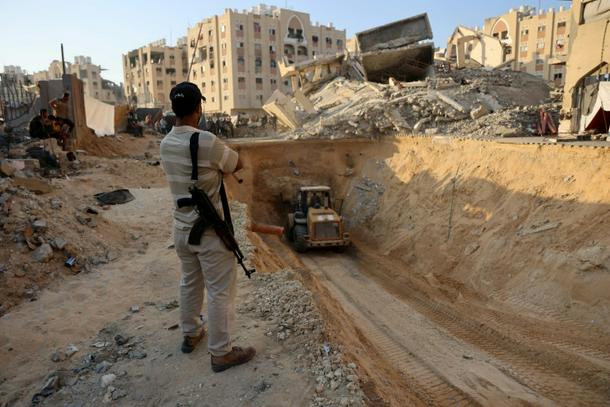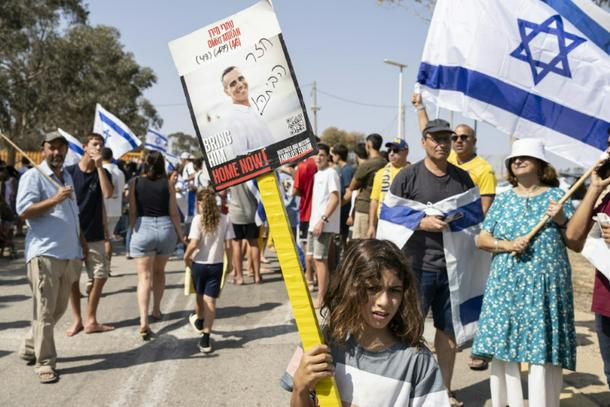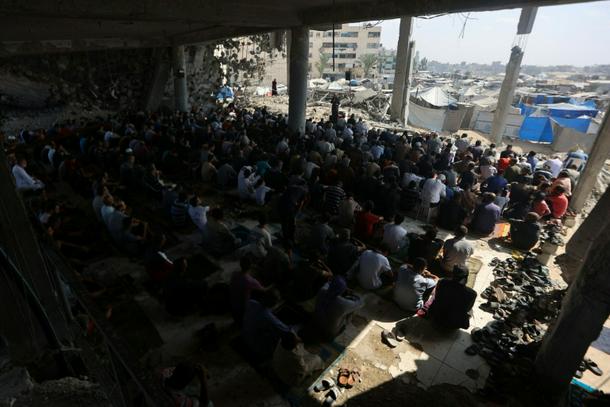
An armed Palestinian man looks at an excavator reportedly digging for the bodies of Israeli hostages
Jerusalem (AFP) - Hamas handed over to Israel the remains of one more hostage on Friday night, after insisting it was committed to returning all the dead captives still unaccounted for under Gaza’s ruins after two years of war.
“Israel received, via the Red Cross, the coffin of a deceased hostage who was returned” to its security forces in Gaza and would be identified at a medical analysis centre in Israel, the prime minister’s office said in a statement.
Under a ceasefire agreement between Israel and Hamas spearheaded by US President Donald Trump, the Palestinian militant group returned all 20 surviving hostages and the remains of nine out of 28 known deceased ones, not counting the remains handed over Friday night.
In exchange, Israel freed nearly 2,000 Palestinian prisoners from its jails and halted the military campaign it launched in Gaza after Hamas’s October 7, 2023 attack.
- Bodies under Gaza rubble -
Israeli Prime Minister Benjamin Netanyahu on Thursday reaffirmed his determination to “secure the return of all hostages”, and his defence minister has warned that the military will restart the war if Hamas fails to do so.
Senior Hamas official Ghazi Hamad on Friday called those threats “unacceptable pressure tactics”.
“The issue of the bodies is complex and requires time, especially after the occupation changed the landscape of Gaza,” Hamad said in a statement.

Crowds gathered for the arrival of Israeli-Hungarian former hostage Omri Miran, returned by Hamas
“We will return the bodies and adhere to the agreement as we promised.”
Turkey dispatched a team of specialists to help retrieve remains buried under the rubble, but the group was still waiting Friday for Israeli permission to enter the territory.
“It remains unclear when Israel will allow the Turkish team to enter Gaza,” a Turkish official told AFP, noting that the team’s mission included locating both Palestinian and hostage remains.
A Hamas source told AFP the Turkish delegation was expected to enter by Sunday.
Gaza’s civil defence agency, a rescue force that operates under Hamas authority, said more than 280 bodies had been recovered from the rubble since the ceasefire went into effect.
- Aid enters Gaza -
The ceasefire deal has seen the war grind to a halt after two years of agony for the hostages’ families, and constant bombardment and hunger for Gazans.
The UN’s World Food Programme said on Friday it had been able to move close to 3,000 tonnes of food supplies into Gaza since the ceasefire took hold.
But it cautioned it would take time to reverse the famine in the Strip, saying all crossings needed to be opened to “flood Gaza with food”.

Muslim Palestinians attended Friday prayers in a destroyed mosque in Khan Yunis
Trump’s 20-point plan for Gaza calls for renewed aid, with international organisations eagerly awaiting the reopening of southern Gaza’s strategic Rafah crossing.
UN humanitarian chief Tom Fletcher said he entered Gaza on Friday, where he watched a convoy of aid head to Rafah from Israel’s Kerem Shalom crossing and later visited a bakery making pita bread.
“We’ve begged for this access for months and finally we’re seeing goods moving at scale: food, medicine, tents, fuel, a lot of fuel got in today,” he said, in a video message posted to social media.
- Identifying the dead -
Families of surviving hostages rejoiced in their return while others buried the returned remains of their loved ones.
“We’ve been waiting for this for so long, two years that we’ve been fighting for him every single day,” said 30-year-old Gal Gilboa Dalal, the older brother of Guy Gilboa Dalal, who was released after two years in Hamas captivity.
Gal told AFP that Hamas had intentionally starved his brother and another prisoner for three and a half months to use him as a prop in a propaganda video about hunger.
“Their bones hurt, their muscles hurt. Their recovery will be very long.”
At the Nasser Hospital in Gaza, meanwhile, families searched for their loved ones among the bodies of Palestinians returned by Israel.

Many in Gaza were reeling from the devastation, though there was relief that the bombing had stopped
One, Akram Khalid al-Manasra, told AFP he identified his son “thanks to the birthmark on his nose and his teeth”.
Others were clearing the rubble from their destroyed homes.
“I’m right under the threat of death. It could collapse at any moment,” said Ahmad Saleh Sbeih, a Gaza City resident. “But there is no choice.”
The war has killed at least 67,967 people in Gaza, according to the health ministry in the Hamas-run territory – figures the United Nations considers credible.
The data does not distinguish between civilians and combatants but indicates that more than half of the dead are women and children.
Hamas’s October 7 attack on Israel resulted in the deaths of 1,221 people, mostly civilians, according to an AFP tally based on official Israeli figures.